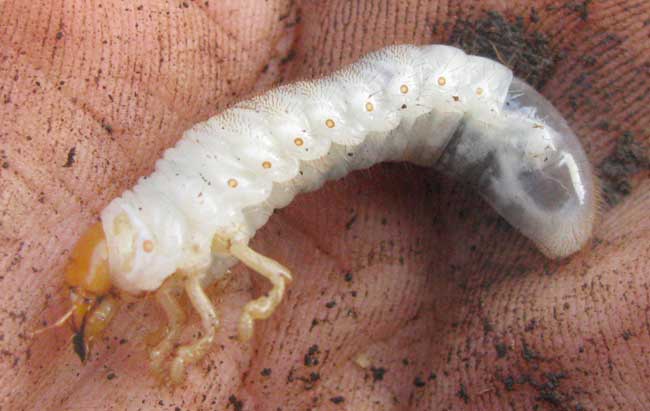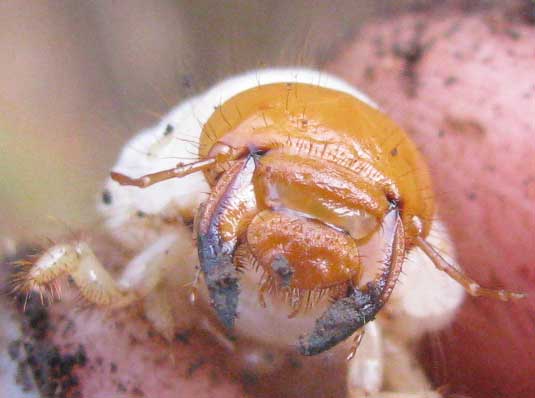Excerpts from Jim Conrad's
Naturalist Newsletter

from the June 27, 2010 Newsletter issued from Hacienda Chichen Resort beside Chichén Itzá Ruins, central Yucatán, MÉXICO; limestone bedrock, elevation ~39m (~128ft), ~N20.676°, ~W88.569°
WHITE GRUBS
In the organic garden while digging a posthole I unearthed the amber-headed, white grub shown above.
When I was a kid on the Kentucky farm digging for fishing worms I was told that such grubs, which made great bait, were cutworms. On the Internet I found that cutworms are very similar to what's shown in my hand but they're structured differently. One obvious difference is that cutworm grubs are hairless, while this grub bristles with stiff, orange trichomes. Also, the rear end of this grub looks as if it's covered with a transparent, bladdery skin, and I couldn't find a cutworm species with anything like that.
Last month, in May, we experienced a massive outbreak of the amber-colored beetles that up north we call June Bugs, or sometimes May Beetles. Each morning the veranda floor had to be swept of hundreds of dead and dying June Bugs, and sometimes the water in the commodes in the public bathroom was covered with them. Remembering that June Bugs, which are members of the genus PHYLLOPHAGA, have a grub-type larva, I looked to see what their larvae were like, and what I found was a good match with the photo. I'm guessing that the grub, then, belongs to the genus Phyllophaga.
Identifying the grub in the picture as probably a June Bug of the genus Phyllophaga wasn't much of an accomplishment. About 207 species of Phyllophaga are listed for North America, with 54 just in Florida, and I'll bet that Mexico has more than North America. The typical life history of a Phyllophaga grub is that it feeds on roots below ground, especially in grassy areas, for one or two years. Grass is killed that is fed on by these larvae but the soil itself is made looser and better aerated where they feed. In the North, life cycles are interrupted by cold weather so that the grubs have to move to below the frost line. Here there's no frost, but I wouldn't be surprised if our grubs dig deeper and maybe have a resting period during the dry season.
The picture below shows some very powerful mandibles:

Especially interesting to me in that picture are the antenna-like appendages sprouting from the blackish lower mandibles. Those aren't antennae, for the antennae emerge just below the big, orange, compound eyes at the top. I'm guessing that they're taste or odor sensors enabling the grub to monitor the chemical content of the roots it eats, so it doesn't eat something that disagrees with it.